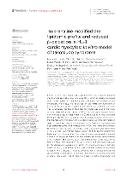| dc.contributor.author | Fišerová, Ivana | |
| dc.contributor.author | Trinh, Minh Duc | |
| dc.contributor.author | Elkalaf, Moustafa | |
| dc.contributor.author | Vacek, Lukáš | |
| dc.contributor.author | Heide, Marek | |
| dc.contributor.author | Martínková, Stanislava | |
| dc.contributor.author | Bechyňská, Kamila | |
| dc.contributor.author | Kosek, Vít | |
| dc.contributor.author | Hajšlová, Jana | |
| dc.contributor.author | Fišer, Ondřej | |
| dc.contributor.author | Toušek, Petr | |
| dc.contributor.author | Polák, Jan | |
| dc.date.accessioned | 2023-01-24T16:10:42Z | |
| dc.date.available | 2023-01-24T16:10:42Z | |
| dc.date.issued | 2022 | |
| dc.identifier.uri | https://hdl.handle.net/20.500.14178/1681 | |
| dc.description.abstract | Recent studies have suggested a pathogenetic link between impaired mitochondria and Takotsubo syndrome (TTS), which is closely connected with catecholamine overstimulation, poor outcomes, and changes in lipid metabolism. We investigated the changes in lipid metabolism at the level of fatty acid β-oxidation and changes in the intracellular lipidomic spectrum. The immortalized cell line of HL-1 cardiomyocytes was used in this study as an established in vitro model of TTS. The cells were exposed to the non-selective β-agonist isoprenaline (ISO) for acute (2 h) and prolonged (24 h) periods. We investigated the impact on mitochondrial adenosine 5'-triphosphate (ATP) production and β-oxidation using real-time cell metabolic analysis, total lipid content, and changes in the lipidomic spectrum using high-performance liquid chromatography (HPLC) and mass spectrometry. Furthermore, modifications of selected lipid transporters were determined using real-time - polymerase chain reaction (RT-PCR) and/or Western blot techniques. By choosing this wide range of targets, we provide a detailed overview of molecular changes in lipid metabolism during catecholamine overstimulation. The present study demonstrates that acute exposure to ISO decreased ATP production by up to 42.2%, and prolonged exposure to ISO decreased β-oxidation by 86.4%. Prolonged exposure to ISO also increased lipid accumulation by 4%. Lipid spectrum analysis of prolonged exposure to ISO showed a reduced concentration of cardioprotective and an increased concentration of lipotoxic lipid molecules during long-term exposure. Decreased lipid utilization can lead to higher intracellular lipid accumulation and the formation of lipotoxic molecules. Changes in the lipid spectrum can induce pathophysiological signaling pathways leading to cardiomyocyte remodeling or apoptosis. Thus, changes in lipid metabolism induced by excessive doses of catecholamines may cause TTS and contribute to a progression of heart failure, which is at increased risk after a TTS episode. | en |
| dc.language.iso | en | |
| dc.relation.url | https://doi.org/10.3389/fcvm.2022.917989 | |
| dc.rights | Creative Commons Uveďte původ 4.0 International | cs |
| dc.rights | Creative Commons Attribution 4.0 International | en |
| dc.title | Isoprenaline modified the lipidomic profile and reduced β-oxidation in HL-1 cardiomyocytes: In vitro model of takotsubo syndrome | en |
| dcterms.accessRights | embargoedAccess | |
| dcterms.license | https://creativecommons.org/licenses/by/4.0/legalcode | |
| dc.date.updated | 2023-10-02T06:15:09Z | |
| dc.subject.keyword | takotsubo | en |
| dc.subject.keyword | isoprenaline | en |
| dc.subject.keyword | cardiomyocyte | en |
| dc.subject.keyword | lipid | en |
| dc.subject.keyword | fatty acid | en |
| dc.subject.keyword | mitochondria | en |
| dc.subject.keyword | metabolism | en |
| dc.relation.fundingReference | info:eu-repo/grantAgreement/UK/GAUK/GAUK1658119 | |
| dc.relation.fundingReference | info:eu-repo/grantAgreement/UK/UNCE/UNCE 204010/2012 | |
| dc.relation.fundingReference | info:eu-repo/grantAgreement/UK/COOP/COOP | |
| dc.relation.fundingReference | info:eu-repo/grantAgreement/MSM//LX22NPO5104 | |
| dc.date.embargoStartDate | 2023-10-02 | |
| dc.date.embargoEndDate | 2023-01-24 | |
| dc.type.obd | 73 | |
| dc.type.version | info:eu-repo/semantics/publishedVersion | |
| dc.identifier.doi | 10.3389/fcvm.2022.917989 | |
| dc.identifier.utWos | 000854013900001 | |
| dc.identifier.eidScopus | 2-s2.0-85137784623 | |
| dc.identifier.obd | 613770 | |
| dc.identifier.riv | RIV/00216208:11120/22:43923803 | |
| dc.identifier.riv | RIV/00216208:11150/22:10446112 | |
| dc.identifier.pubmed | 36072861 | |
| dc.subject.rivPrimary | 30000::30200::30201 | |
| dc.subject.rivSecondary | 30000::30200::30202 | |
| dcterms.isPartOf.name | Frontiers in Cardiovascular Medicine [online] | |
| dcterms.isPartOf.issn | 2297-055X | |
| dcterms.isPartOf.journalYear | 2022 | |
| dcterms.isPartOf.journalVolume | 9 | |
| dcterms.isPartOf.journalIssue | August | |
| uk.faculty.primaryId | 110 | |
| uk.faculty.primaryName | 3. lékařská fakulta | cs |
| uk.faculty.primaryName | Third Faculty of Medicine | en |
| uk.faculty.secondaryId | 112 | |
| uk.faculty.secondaryName | Lékařská fakulta v Hradci Králové | cs |
| uk.faculty.secondaryName | Faculty of Medicine in Hradec Kralove | en |
| uk.department.primaryId | 110 | |
| uk.department.primaryName | 3. lékařská fakulta | cs |
| uk.department.primaryName | Third Faculty of Medicine | en |
| uk.department.secondaryId | 634 | |
| uk.department.secondaryId | 656 | |
| uk.department.secondaryId | 581 | |
| uk.department.secondaryId | 576 | |
| uk.department.secondaryName | Kardiologická klinika 3. LF UK a FNKV | cs |
| uk.department.secondaryName | Department of Cardiology 3FM CU and UHKV | en |
| uk.department.secondaryName | Ústav fyziologie | cs |
| uk.department.secondaryName | Department of Physiology | en |
| uk.department.secondaryName | Ústav patofyziologie 3. LF UK | cs |
| uk.department.secondaryName | Department of Pathophysiology 3FM CU | en |
| uk.department.secondaryName | Ústav biochemie, buněčné a molekulární biologie 3. LF UK | cs |
| uk.department.secondaryName | Department of Biochemistry, Cell and Molecular Biology 3FM CU | en |
| dc.description.pageRange | nestránkováno | |
| dc.type.obdHierarchyCs | ČLÁNEK V ČASOPISU::článek v časopisu::původní článek | cs |
| dc.type.obdHierarchyEn | JOURNAL ARTICLE::journal article::original article | en |
| dc.type.obdHierarchyCode | 73::152::206 | en |
| uk.displayTitle | Isoprenaline modified the lipidomic profile and reduced β-oxidation in HL-1 cardiomyocytes: In vitro model of takotsubo syndrome | en |

